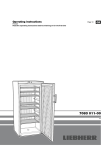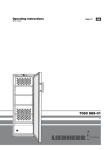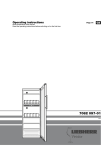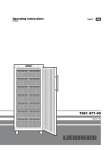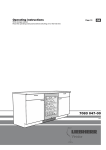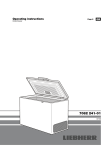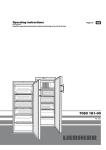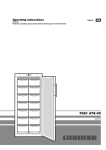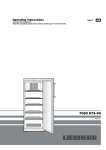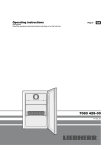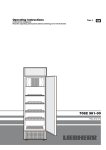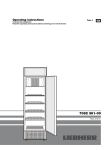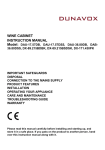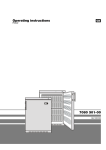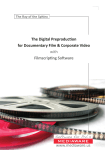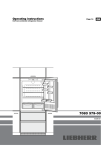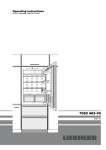Download Operating instructions
Transcript
Operating instructions
Freezer
Read the operating instructions before switching on for the first time
Page 12
GB
7083 005-00
GGU 15
Content
Description of the appliance.................................................... 12
Noise emissions from the appliance....................................... 12
Disposal notes......................................................................... 12
Safety instructions and warnings............................................ 13
Range of appliance use........................................................... 13
Climate rating.......................................................................... 14
Setting up................................................................................ 14
Levelling the appliance............................................................ 14
Installation dimensions (mm)................................................... 14
Safety lock............................................................................... 14
Electrical connection............................................................... 15
Operating and control elements.............................................. 15
Switching the appliance on and off......................................... 15
Setting the temperature........................................................... 15
Door open alarm...................................................................... 15
Temperature alarm.................................................................. 15
Setup mode............................................................................. 16
Freezing.................................................................................. 17
SuperFrost............................................................................... 17
Notes on freezing.................................................................... 17
Defrosting................................................................................ 17
Cleaning.................................................................................. 17
Malfunctions............................................................................ 18
Shutting your appliance down................................................. 18
Changing over door hinges..................................................... 18
Disposal notes
The appliance contains reusable materials and should
be disposed of properly - not simply with unsorted
household refuse. Appliances which are no longer
needed must be disposed of in a professional and
appropriate way, in accordance with the current local
regulations and laws.
When disposing of the appliance, ensure that the refrigerant circuit
is not damaged to prevent uncontrolled escape of the refrigerant
it contains (data on type plate) and oil.
• Disable the appliance.
• Pull out the mains plug.
• Cut through the connection cable.
WARNING
Danger of suffocation due to packing material
and plastic film!
Do not allow children to play with packaging
material.
Take the packaging material to an official collection point.
Description of the appliance
Operating and control elements
Type plate
Adjustable-height feet
Noise emissions from the appliance
The noise level while the appliance is operating is
below 70 dB(A) (relative noise level 1 pW).
12
Safety instructions and warnings
•To prevent injury or damage to the unit, the appliance should be unpacked and set up by two
people.
•In the event that the appliance is damaged on
delivery, contact the supplier immediately before
connecting to the mains.
•To guarantee safe operation, ensure that the appliance is set up and connected as described in
these operating instructions.
•Disconnect the appliance from the mains if any
fault occurs. Pull out the plug, switch off or remove
the fuse.
•When disconnecting the appliance, pull on the
plug, not on the cable.
•Any repairs and work on the appliance should
only be carried out by the customer service
department, as unauthorised work could prove
highly dangerous for the user. The same applies
to changing the mains power cable.
•Do not allow naked flames or ignition sources
to enter the appliance. When transporting and
cleaning the appliance ensure that the refrigerant
circuit is not damaged. In the event of damage,
make sure that there are no ignition sources
nearby and keep the room well ventilated.
•Do not stand on the plinth, drawers or doors or
use them to support anything else.
•This appliance can be used by children of 8 years
old and over, and also by persons with restricted
physical, sensory or mental capacity or lack of
experience and knowledge, if they are supervised
or have been instructed on safe use of the appliance and understand the resulting risks. Children
must not be allowed to play with the appliance.
Cleaning and user maintenance must not be
carried out by children without supervision.
GB
•Do not store explosives or sprays using combustible propellants such as butane, propane,
pentane, etc. in the appliance. Electrical components might cause leaking gas to ignite. You
may identify such sprays by the printed contents
or a flame symbol.
•Do not use electrical appliances inside the appliance.
•If you have a lockable appliance, do not keep the
key near the appliance or within reach of children.
•The appliance is designed for use in enclosed
areas. Do not operate the appliance outdoors or
in areas where it is exposed to splash water or
damp conditions.
Range of appliance use
The appliance is suitable solely for cooling food
in a domestic environment or similar.
This includes, for example, use
- in staff kitchenettes, bed and breakfast establishments,
-by guests in cottages, hotels, motels and other
forms of accommodation,
-in catering and similar services in the wholesale
trade.
Use the appliance solely as is customary within a domestic environment. All other types of use are inadmissible.
The appliance is not suitable for storing and cooling medicines,
blood plasma, laboratory preparations or similar substances and
products covered by the 2007/47/EC Medical Devices Directive.
Any misuse of the appliance may result in damage to or spoilage
of stored goods.
Furthermore, the appliance is not suitable for operation in potentially explosive atmospheres.
•Avoid prolonged skin contact with cold surfaces or
chilled/frozen food.This could cause pain, numbness and frostbite. In the case of prolonged skin
contact, protective measures should be taken,
e.g. gloves should be worn.
•Do not eat ice cream, particulary ice lollies or ice
cubes, immediately after taking them from the
freezer compartment as there is a risk of "burning" because of the very cold temperatures.
•Do not consume food which has been stored for
too long, as it could cause food poisoning.
13
Climate rating
The climate rating indicates the room
temperature at which the appliance may
be operated in order to achieve full refrigeration performance.
The climate rating is indicated on the
type plate.
Installation dimensions (mm)
Version 1
A cross-section of min. 200 cm2 is required in the
worktop for ventilation of the rear of the appliance.
The position of the type plate is shown in the section entitled
Description of the appliance.
Climate rating
4 (SN)
4 (N)
4+ (ST)
4+ (SN-ST)
5 (T)
5 (SN-T)
Room temperature
+10°C to +32°C
+16°C to +32°C
+16°C to +38°C
+10°C to +38°C
+16°C to +43°C
+10°C to +43°C
Do not operate the appliance outside the
specified room temperature range.
Setting up
• Do not place the appliance in direct sunlight or near cookers,
radiators and similar sources of heat.
• Do not cover ventilation openings
or grille.
• Do not place heat-emitting appliances, e.g.
microwave oven, toaster, etc., on top of the
freezer.
Version 2
If no ventilation grill is provided in the worktop, the recess
must be at least 860 mm high to ensure adequate heat
dissipation to the front.
• Standard EN 378 specifies that the room in
which you install your appliance must have
a volume of 1 m3 per 8 g of R 600a refrigerant used in the appliance, so as to avoid the
formation of inflammable gas/air mixtures in the room where the
appliance is located in the event of a leak in the refrigerant circuit.
The quantity of refrigerant used in your appliance is indicated on
the type plate on the inside of the appliance.
• Always install the appliance directly against the wall.
Levelling the appliance
• Place the appliance in its final position
at the place of installation.
• Compensate floor unevenness using the
adjustable feet.
Important
The appliance must be aligned horizontally and vertically. If the appliance
is not level, the main body of the appliance can be deformed and the door
will not close properly.
Safety lock
The lock in the appliance door is equipped with a safety mechanism.
Locking the appliance
• Insert the key as shown by arrow 1.
• Turn the key 90°.
To unlock the appliance, the same
procedure must be repeated in the
same order.
14
Electrical connection
Only operate the appliance with alternating current (AC).
The permissible voltage and frequency are indicated on the type
plate. The position of the type plate is shown in the section entitled
Description of the appliance.
The socket must be properly earthed and protected by a fuse.
The tripping current of the fuse must be between 10 A and 16 A.
The socket must not be situated behind the appliance and must be easily accessible.
Do not connect the appliance using an extension cable or extension socket.
Keep pressing the Up/Down button until
the desired value is displayed.
After a certain period of operation, the interior temperature will
adjust to the value which has been set.
If F3 appears in the display, the appliance has suffered a fault. In
this case, contact the customer service department.
If the door is left open for more than 180 seconds, the audible
warning signal will sound.
If the door must be opened for a lengthy period to place
items into the appliance, cancel the audible warning
signal by pressing the Alarm button.
The alarm switches back to standby when the door is shut.
Operating and control elements
1
4
Press the Up/Down button, the next lower
temperature value in the temperature
display will light up.
Door open alarm
Do not use stand-alone inverters (conversion
of direct current to alternating/three-phase
current) or energy-saving plugs. Risk of damage to the electronic control system!
3
Setting the temperature
GB
2
5
Temperature alarm
If the temperatures in the interior are out of the permitted range,
the audible warning signal will sound and the temperature display
will flash.
The audible warning device is switched off by pressing
the Alarm button.
1 Temperature display (display)
2 Temperature button
3 On/Off button
4 SuperFrost button
5 Audible warning on/off button
Symbols in the display
Setup mode is activated (activating the child lock and
adjusting the display brightness)
Alarm (symbol flashes if the temperature inside the appliance is too high)
The temperature display will continue to flash until the
cause of the alarm has been rectified.
This can be caused by:
• the freezer door being left open for a long time, allowing warm
ambient air to enter;
• a long power failure;
• a fault in the appliance.
In each case, make sure food has not thawed or perished.
Power failure display
Child lock is activated
If
appears in the display, the freezer temperature has risen
too high due to a power failure.
Power failure symbol
• Press the Alarm button.
SuperFrost is on
Demo mode is activated
The highest temperature during
the power failure will be displayed.
Switching the appliance on and off
Check the quality of the food depending on the temperature
displayed.
Press the On/Off button until the temperature display
lights up.
Do not eat perished food!
Switching the appliance off
Press the Alarm button again to cancel the display.
Switching the appliance on
Keep the On/Off button pressed for approx. 3 seconds so that
the temperature display goes out.
Do not refreeze thawed food!
15
Set-up mode
In set-up mode you can set the child lock and adjust the brightness of the display.
Adjusting the display brightness
The child lock is designed to protect the appliance from being
switched off and the temperature setting from being changed
accidentally.
Press
Activating the child lock
Press
for 5 seconds. Display =
for 5 seconds. Display =
Display =
Display =
Display =
Display =
Display =
Adjust to the desired brightness using the
Up/Down button.
h0 = minimum brightness
h5 = maximum brightness
Display =
The adjusted brightness will be activated after one
minute.
The child lock is activated.
Note
Deactivating the child lock
If a button is pressed, the display lights up for one minute at
maximum brightness.
Press
When commissioning the appliance, the adjusted brightness will
only be active once the set interior temperature of the appliance
has been reached.
for 5 seconds. Display =
Display =
Display =
Display =
The child lock is deactivated.
Demo mode
Demo mode can be activated for presenting the appliance at
exhibitions or in salesrooms as though in normal operating mode.
DEMO appears in the display.
When in this mode, the cooling circuit is switched off!
If this mode is activated by accident, it can be deactivated as
detailed below.
Press
+
for 5 seconds.
Display =
Display =
Display =
The refrigeration unit switches on.
The temperature display flashes.
The appliance is now in normal operating mode.
16
Freezing
The maximum amount of food
(in kg) which can be frozen in
24 hours is shown on the type
plate ("Freezing capacity").
Defrosting
GB
After a longer period of operation a layer of frost or ice can build up
on the cooling plates in the freezer compartment. This will increase
the energy consumption of the freezer.
The cooling plates should therefore be defrosted regularly.
• Switch the appliance off to defrost. Remove the plug.
SuperFrost
By activating the SuperFrost function the temperature in the freezer
compartment will drop to the lowest attainable value.
Thus food can be rapidly frozen to the core and the quality is
preserved.
• Press the SuperFrost button. The
symbol appears in the display.
• Wait 24 hours.
• Wrap the frozen food in paper or blankets and store in a cool
place.
• Leave the door of the appliance open while defrosting.
After defrosting mop up the remaining water and clean the appliance.
Do not use any mechanical devices or other
artificial aids for defrosting other than those
recommended by the manufacturer.
• Place the fresh food in the freezer.
• The automatic SuperFrost system automatically switches the
fast freezing procedure off after 65 hours.
Cleaning
Clean the appliance at least twice per year.
Notes on freezing
• Always store identical food items together.
Before cleaning, always switch off the appliance. Disconnect
from the mains or switch off or unscrew the fuse.
• Clean the inside, equipment parts and outer walls with lukewarm
water and a little detergent.
• Pack frozen food in standard freezer bags or reuseable plastic,
metal or aluminium containers.
Do not use abrasive or acid cleaners or chemical solvents.
• Do not allow fresh food which is to be frozen to come into contact
with food already frozen. Always keep packs dry in order to avoid
them sticking together.
Do not use steam cleaners because of the
risk of injury and damage.
• Always write the date and contents on the pack and do not exceed
the stated storage time for the food.
• Do not freeze bottles and cans which contain carbonated drinks
as they might burst.
• Ensure that no cleaning water penetrates
into the electrical components or ventilation
grille.
• Only take out as much food as is immediately required for thawing.
Use food which has been thawed in prepared meals as quickly
as possible.
• Dry all parts well with a cloth.
Frozen food can be thawed in the following ways:
–in a fan oven
–in a microwave oven
–at room temperature
–in the refrigerator
• The dust should be removed from the refrigeration unit and heat exchanger - metal
grid at the back of the appliance - once a
year.
• Do not damage or remove the type plate on
the inside of the appliance. It is very important
for servicing purposes.
17
Malfunctions
• F3 appears in the display.
–The appliance has suffered a fault. Contact the customer service
department.
Changing over door hinges
You may be able to rectify the following faults by checking
the possible causes yourself.
• Appliance does not function:
–Is the appliance switched on?
–Is the plug correctly fitted in the mains socket?
–Is the fuse intact?
• When inserting the mains plug, the refrigeration unit does
not switch on, but a value is shown in the temperature
display.
–Demo mode is activated. Deactivate demo mode as described
in the section entitled Demo mode.
• Loud running noise:
–Is the appliance set up firmly on the floor?
–Does the appliance cause nearby items of furniture or objects to
vibrate? Please note that noises caused by the refrigerant circuit
cannot be avoided.
• The temperature is not low enough:
– Is the temperature setting correct (see "Setting the temperature")?
– Does the separately installed thermometer show the correct
reading?
– Is the ventilation system working properly?
– Is the appliance set up too close to a heat source?
If none of the above causes
apply and you cannot rectify the fault yourself, contact
the nearest customer service department stating the
type designation 1, service
number 2 and appliance
number 3as indicated on the
type plate.
1
1. Unscrew the hinge bracket.
2
The position of the type plate is shown in the section entitled
Description of the appliance.
2. Pull the door out at the
bottom and lift off.
Shutting your appliance down
If your appliance is to be shut down for any length of time, switch
it off and disconnect the plug or switch off or unscrew the fuse.
Clean the appliance and leave the door open in order to prevent
unpleasant smells.
The appliance complies with the relevant safety regulations and
EC Directives 2004/108/EC and 2006/95/EC.
3
3. Transfer handle and plugs to the
opposite side of the door.
18
GB
9
8
4
8. Turn the lock approx. 3° clockwise.
9. Remove pin.
4. Insert key.
5
10
5. Push in the key.
Turn the key 90°.
10. Turn the lock 90° clockwise.
6
7
6. Remove cover.
7. Remove screw.
11
11. Remove lock.
19
16
15. Turn the lock further - approx. 3° clockwise.
12
16. Insert pin.
15
12.Transfer covers to the opposite
side.
Note on point 16
After insertion, the pin's cross pin must be
engaged in the groove of the catch.
17
13
17. Screw in the screw and attach
the cover cap.
13. Insert the lock as shown in
the illustration.
18. Push in the key.
14. Turn back the lock 90°
anticlockwise.
20
14
Turn the key 90°.
18
GB
19. Move the pin at the top
to the other side.
19
20
20. Transfer cover plate to the opposite
side.
23.Insert hinge bracket in lower door
mounting and screw into place.
23
Adjusting the lateral tilt of the door
If the door is at an angle, adjust the angle.
21
21. Transfer pin on hinge bracket to the opposite side.
22. Mount door on hinge pin and
close.
22
24. Undo screws and slide hinge
bracket to the right or left.
Tighten screws.
24
21












